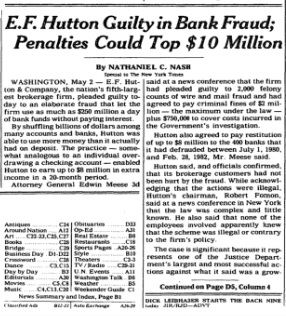How Criminal Charges Against a Wall Street Icon Went from Front Page News to a Yawn at the New York Times
On May 2, 1985 the highest law enforcement officer in the United States, the head of the U.S. Department of Justice, Attorney General Edwin Meese, held a news conference to announce that the sixth largest brokerage firm on Wall Street, E.F. Hutton, was pleading guilty to 2,000 felony counts of wire and mail fraud. It had also agreed to pay criminal fines of $2 million and up to $8 million in restitution to the 400 banks it had defrauded. The fraud had lasted less than two years, from July 1, 1980 and February 28, 1982, and consisted of the following according to the Justice Department:
“The essence of the charges was that Hutton obtained the interest-free use of millions of dollars by intentionally writing checks in excess of the funds it had on deposit in various banks.”
On the following day, Friday, May 3, the New York Times put that story on the front page of its newspaper.
Now, carefully consider what happened three weeks ago.
On September 29, 2020, the U.S. Department of Justice sent out a press release announcing that it was bringing two criminal charges against the largest Wall Street bank in the United States. No press conference was held. The press release indicated that JPMorgan Chase had committed “tens of thousands of episodes of unlawful trading in the markets for precious metals” and “thousands of episodes of unlawful trading in the markets for U.S. Treasury futures and in the secondary (cash) market for U.S. Treasury notes and bonds.” The bank agreed to pay $920 million in fines and restitution.
This was the fourth and fifth criminal count to which JPMorgan Chase had pleaded guilty since 2014 — an unthinkable and unprecedented history of criminal conduct by the largest bank in the United States. But the New York Times did not run one word about these latest criminal charges on its front page. In fact, no story at all, that we could find, appeared in the print edition of the newspaper.
JPMorgan has been headquartered in Manhattan where the New York Times is located for more than a century. It has 5,239 federally-insured bank branches spread across the country. It holds $1.7 trillion in domestic deposits for moms and pops, small and large businesses, public pension funds, states and municipalities across America. And yet getting slapped with five criminal felony counts in a span of six years is not front-page news at the New York Times. It doesn’t even warrant coverage anywhere in the newspaper.
The Criminal Information (details of charges) filed by the Justice Department, and linked at the bottom of the press release, indicated that JPMorgan Chase had not, like E.F. Hutton, been engaged in this fraud for less than two years, but had been rigging the precious metals market for more than eight years and the U.S. Treasury market for just under eight years.



